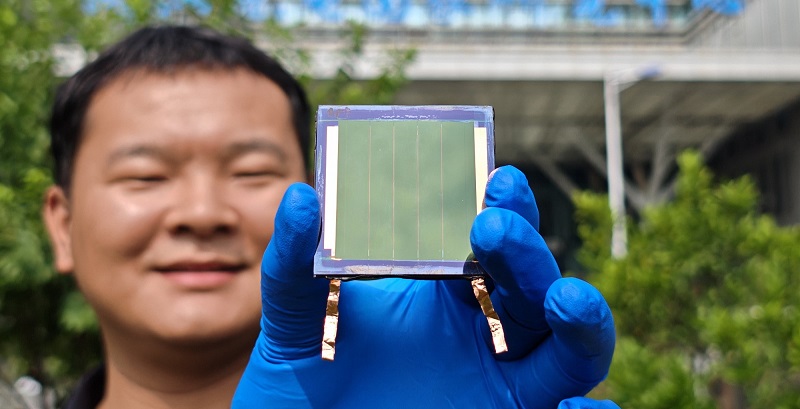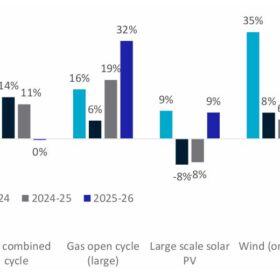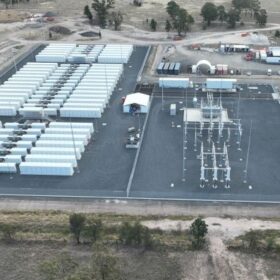An international research team led by China’s Huazhong University of Science and Technology has improved the efficiency of (Sn-Pb) single junction tin lead perovskite solar cells, as well as all-perovskite tandem and mini-module variations. using a novel mercapto-functionalised scaffold interfacial engineering strategy.
In the study, “Mercapto-functionalised scaffold improves perovskite buried interfaces for tandem photovoltaics,” published in nature communications, the researchers describe how their approach enabled a single-junction narrow bandgap (NBG) tin lead perovskite solar cell with a power conversion efficiency of 23.7%, a two-terminal (2T) all-perovskite tandem solar cell with a certified efficiency of 29.5% and 24.7%-efficient mini-modules measuring 5 × 5 cm2.
As for stability testing, the modified solar cells consistently outperformed control devices, according to the research.
“The compatibility of our strategy across multiple architectures was highly encouraging. We successfully applied it to narrow-bandgap tin lead (Sn-Pb) perovskites, wide-bandgap (WBG) perovskites, and conventional-bandgap perovskites,” Zonghao Liu, corresponding author, told pv magazine. “This universal interfacial engineering approach demonstrates significant potential for scaling perovskite solar modules.”
To begin with, the group identified nanovoids or microscopic voids at the buried interface between the PEDOT:PSS hole transport layer (HTL) and the narrow-bandgap tin-lead perovskite as a critical factor degrading device performance, according to Liu.
“To address this, we developed a mercapto-functionalised mesoporous silica nanoscaffold strategy. This approach simultaneously modulates perovskite crystallization to eliminate nanovoids, suppresses the tin(II) oxidation, passivates interfacial defects, and enhances charge extraction,” Liu said.
The superstructure scaffold was composed of (3-mercaptopropyl)trimethoxysilane (MPTS) functionalized mesoporous silica nanoparticles (MSN), which the researchers denoted as MSN-SH.
Several devices were demonstrated and characterised in the study. The NBG solar cells had an open circuit voltage of up to 0.89 V and an efficiency of 23.7%. Further tests with the MSN-SH treatment were conducted on neat lead cells with bandgaps of 1.52 eV, 1.68 eV, and 1.77 eV and compared to control devices. The team found that the buried interface modification method was consistently effective. In particular, the 1.77 eV wide bandgap (WBG) solar cell achieved an efficiency of up to 20.6% with an open-circuit voltage of 1.33 V. in line with the certified results.
To further demonstrate the technology, a monolithic 2T all-perovskite tandem cell was fabricated. It had a certified efficiency of 29.50% and a maximum power point efficiency of 28.7%. The performance was certified by the Shanghai Institute of Microsystem and Information Technology in China.
“Encouragingly, this is one of the highest performance values reported for the monolithic two-terminal all-perovskite tandems, to the best of our knowledge,” the researchers said.
The all-perovskite tandem device stack was as follows: glass, indium tin oxide (ITO), a methyl-substituted carbazole (Me-4PACz) hole transport layer (HTL), a MSN-SH/WBG perovskite absorber, a 1,3-propanediamine dihydriodide (PDAI2) passivation layer, a buckminsterfullerene (C60) electron transport layer (ETL), a bathocuproine (BCP) buffer layer, tin oxide (SnO), a gold (AU) metal contact, a PEDOT:PSS HTL, the MSN-SH, NBG perovskite layer, a ethylenediammonium diiodide (EDAI2) passivation layer, C60, BCP, and Ag.
In thermal stability tests the tandem device retained 82% of its initial efficiency over 150 h at 85 C, while the control devices retained “only 43% of their initial efficiency after 100 h,” reported the scientists.
Additionally, the MSN-SH-based device exhibited “promising” operational stability under MPPT conditions with 93% of the initial efficiency retained after 450 h, which is better compared to 68% after 370 h for the control device.
The tandem mini-modules were made on 5 × 5 cm2 glass substrates with a subcell width of 6.8 mm. Testing revealed an average efficiency of 24.2% and a best value of 24.7%. The encapsulated MSN-SH mini-module could also maintain over 80% of the initial efficiency after over 290 h of continuous operation.
The team said that these results suggest a “superior upscaling potential of the MSN-SH buried interface modification for multijunction devices,” stressing that the design strategy provides “valuable insights for the community in developing functional superstructures that can precisely modulate the buried interface for solar cells and other optoelectronic devices.”
Looking at future research topics, Liu said work will continue along these lines, investigating new functionalized nano-scaffolds, possibly using alternative ligand groups, with the focus being on further charge transport optimization and long-term operational stability. The group may also apply the strategy to other optoelectronic devices such as photodetectors and light-emitting diodes (LED).
The research team included scientists from the Chinese Academy of Sciences, Huaneng Clean Energy Research Institute, East China University of Science and Technology, Shenzhen Polytechnic University, Southern University of Science and Technology, SUSTech Energy Institute for Carbon Neutrality, Wuhan University of Technology, Optics Valley Laboratory, all based in China, along with researchers from the University of Oxford, in the UK, and Kyoto University, Japan.
This content is protected by copyright and may not be reused. If you want to cooperate with us and would like to reuse some of our content, please contact: editors@pv-magazine.com.








By submitting this form you agree to pv magazine using your data for the purposes of publishing your comment.
Your personal data will only be disclosed or otherwise transmitted to third parties for the purposes of spam filtering or if this is necessary for technical maintenance of the website. Any other transfer to third parties will not take place unless this is justified on the basis of applicable data protection regulations or if pv magazine is legally obliged to do so.
You may revoke this consent at any time with effect for the future, in which case your personal data will be deleted immediately. Otherwise, your data will be deleted if pv magazine has processed your request or the purpose of data storage is fulfilled.
Further information on data privacy can be found in our Data Protection Policy.